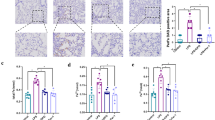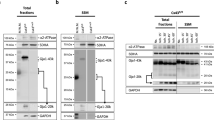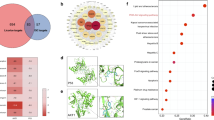Abstract
It has been well demonstrated that hypoxic preconditioning (HPC) can attenuate hypoxia/reoxygenation (H/R)-induced oxidant stress and elicit delayed cardioprotection by upregulating the expression of multiple antioxidative enzymes such as heme oxygenase-1 (HO-1), manganese superoxide dismutase (MnSOD) and so on. However, the underlying mechanisms of HPC-induced upregulation of antioxidative enzymes are not fully understood. Nuclear factor erythroid 2-related factor 2 (Nrf2) is an essential transcription factor that regulates expression of several antioxidant genes via binding to the antioxidant response element (ARE) and plays a crucial role in cellular defence against oxidative stress. Here, we wondered whether activation of the Nrf2–ARE pathway is responsible for the induction of antioxidative enzymes by HPC and contributes to the delayed cardioprotection of HPC. Cellular model of HPC from rat heart-derived H9c2 cells was induced 24 h prior to H/R. The results showed that HPC efficiently attenuated H/R-induced viability loss and lactate dehydrogenase leakage. In addition, HPC increased nuclear translocation and ARE binding of Nrf2 during the late phase, upregulated the expression of antioxidative enzymes (HO-1 and MnSOD), inhibited H/R-induced oxidant stress. However, when Nrf2 was specifically knocked down by siRNA, the induction of antioxidative enzymes by HPC was completely abolished and, as a result, the inhibitory effect of HPC on H/R-induced oxidant stress was reversed, and the delayed cardioprotection induced by HPC was also abolished. These results suggest that HPC upregulates antioxidative enzymes through activating the Nrf2–ARE pathway and confers delayed cardioprotection against H/R-induced oxidative stress.





Similar content being viewed by others
References
Murry CE, Jennings RB, Reimer KA (1986) Preconditioning with ischemia: a delay of lethal cell injury in ischemic myocardium. Circulation 74:1124–1136
Arstall MA, Zhao YZ, Hornberger L, Kennedy SP, Buchholz RA, Osathanondh R, Kelly RA (1998) Human ventricular myocytes in vitro exhibit both early and delayed preconditioning responses to simulated ischemia. J Mol Cell Cardiol 30:1019–1025. doi:10.1006/jmcc.1998.0666
Webster KA, Discher DJ, Bishopric NH (1995) Cardioprotection in an in vitro model of hypoxic preconditioning. J Mol Cell Cardiol 27:453–458
Yamashita N, Nishida M, Hoshida S, Kuzuya T, Hori M, Taniguchi N, Kamada T, Tada M (1994) Induction of manganese superoxide dismutase in rat cardiac myocytes increases tolerance to hypoxia 24 hours after preconditioning. J Clin Invest 94:2193–2199. doi:10.1172/JCI117580
Yellon DM, Downey JM (2003) Preconditioning the myocardium: from cellular physiology to clinical cardiology. Physiol Rev 83:1113–1151. doi:10.1152/physrev.00009.2003
Das DK, Maulik N (2006) Cardiac genomic response following preconditioning stimulus. Cardiovasc Res 70:254–263. doi:10.1016/j.cardiores.2006.02.023
Bolli R (1996) The early and late phases of preconditioning against myocardial stunning and the essential role of oxyradicals in the late phase: an overview. Basic Res Cardiol 91:57–63
Rizvi A, Tang XL, Qiu Y, Xuan YT, Takano H, Jadoon AK, Bolli R (1999) Increased protein synthesis is necessary for the development of late preconditioning against myocardial stunning. Am J Physiol 277:874–884
Vanden Hoek T, Becker LB, Shao ZH, Li CQ, Schumacker PT (2000) Preconditioning in cardiomyocytes protects by attenuating oxidant stress at reperfusion. Circ Res 86:541–548
Morihira M, Hasebe N, Baljinnyam E, Sumitomo K, Matsusaka T, Izawa K, Fujino T, Fukuzawa J, Kikuchi K (2006) Ischemic preconditioning enhances scavenging activity of reactive oxygen species and diminishes transmural difference of infarct size. Am J Physiol Heart Circ Physiol 290:577–583. doi:10.1152/ajpheart.00817.2004
Hoshida S, Yamashita N, Otsu K, Hori M (2002) The importance of manganese superoxide dismutase in delayed preconditioning: involvement of reactive oxygen species and cytokines. Cardiovasc Res 55:495–505
Zhou X, Zhai X, Ashraf M (1996) Direct evidence that initial oxidative stress triggered by preconditioning contributes to second window of protection by endogenous antioxidant enzyme in myocytes. Circulation 93:1177–1184
Jancso G, Cserepes B, Gasz B, Benko L, Borsiczky B, Ferenc A, Kurthy M, Racz B, Lantos J, Gal J, Arato E, Sinayc L, Weber G, Roth E (2007) Expression and protective role of heme oxygenase-1 in delayed myocardial preconditioning. Ann N Y Acad Sci 1095:251–261. doi:10.1196/annals.1397.029
Kaspar JW, Niture SK, Jaiswal AK (2009) Nrf2:INrf2 (Keap1) signaling in oxidative stress. Free Radic Biol Med 47:1304–1309. doi:10.1016/j.freeradbiomed.2009.07.035
Nguyen T, Nioi P, Pickett CB (2009) The Nrf2-antioxidant response element signaling pathway and its activation by oxidative stress. J Biol Chem 284:13291–13295. doi:10.1074/jbc.R900010200
Sun Z, Zhang S, Chan JY, Zhang DD (2007) Keap1 controls postinduction repression of the Nrf2-mediated antioxidant response by escorting nuclear export of Nrf2. Mol Cell Biol 27:6334–6349. doi:10.1128/MCB.00630-07
Howden R (2013) Nrf2 and cardiovascular defense. Oxid Med Cell Longev 2013:104308. doi:10.1155/2013/104308
Lee JM, Johnson JA (2004) An important role of Nrf2–ARE pathway in the cellular defense mechanism. J Biochem Mol Biol 37:139–143
Zhang X, Xiao Z, Yao J, Zhao G, Fa X, Niu J (2013) Participation of protein kinase C in the activation of Nrf2 signaling by ischemic preconditioning in the isolated rabbit heart. Mol Cell Biochem 372:169–179. doi:10.1007/s11010-012-1458-9
Mizukami Y, Iwamatsu A, Aki T, Kimura M, Nakamura K, Nao T, Okusa T, Matsuzaki M, Yoshida K, Kobayashi S (2004) ERK1/2 regulates intracellular ATP levels through alpha-enolase expression in cardiomyocytes exposed to ischemic hypoxia and reoxygenation. J Biol Chem 279:50120–50131. doi:10.1074/jbc.M402299200
Jiao JD, Garg V, Yang B, Hu K (2008) Novel functional role of heat shock protein 90 in ATP-sensitive K+ channel-mediated hypoxic preconditioning. Cardiovasc Res 77:126–133. doi:10.1093/cvr/cvm028
Kim JY, Cho HJ, Sir JJ, Kim BK, Hur J, Youn SW, Yang HM, Jun SI, Park KW, Hwang SJ, Kwon YW, Lee HY, Kang HJ, Oh BH, Park YB, Kim HS (2009) Sulfasalazine induces haem oxygenase-1 via ROS-dependent Nrf2 signalling, leading to control of neointimal hyperplasia. Cardiovasc Res 82:550–560. doi:10.1093/cvr/cvp072
Li J, Ichikawa T, Jin Y, Hofseth LJ, Nagarkatti P, Nagarkatti M, Windust A, Cui T (2010) An essential role of Nrf2 in American ginseng-mediated anti-oxidative actions in cardiomyocytes. J Ethnopharmacol 130:222–230. doi:10.1016/j.jep.2010.03.040
Saeed SA, Waqar MA, Zubairi AJ, Bhurgri H, Khan A, Gowani SA, Waqar SN, Choudhary MI, Jalil S, Zaidi AH, Ara I (2005) Myocardial ischaemia and reperfusion injury: reactive oxygen species and the role of neutrophil. J Coll Physicians Surg Pak 15:507–514. doi:http://www.ncbi.nlm.nih.gov/pubmed/16202368
Zweier JL, Talukder MA (2006) The role of oxidants and free radicals in reperfusion injury. Cardiovasc Res 70:181–190. doi:10.1016/j.cardiores.2006.02.025
Park JL, Lucchesi BR (1999) Mechanisms of myocardial reperfusion injury. Ann Thorac Surg 68:1905–1912
Dhalla NS, Elmoselhi AB, Hata T, Makino N (2000) Status of myocardial antioxidants in ischemia-reperfusion injury. Cardiovasc Res 47:446–456
Rui T, Cepinskas G, Feng Q, Kvietys PR (2003) Delayed preconditioning in cardiac myocytes with respect to development of a proinflammatory phenotype: role of SOD and NOS. Cardiovasc Res 59:901–911
Wakabayashi N, Dinkova-Kostova AT, Holtzclaw WD, Kang MI, Kobayashi A, Yamamoto M, Kensler TW, Talalay P (2004) Protection against electrophile and oxidant stress by induction of the phase 2 response: fate of cysteines of the Keap1 sensor modified by inducers. Proc Natl Acad Sci USA 101:2040–2045. doi:10.1073/pnas.0307301101
Huang HC, Nguyen T, Pickett CB (2002) Phosphorylation of Nrf2 at Ser-40 by protein kinase C regulates antioxidant response element-mediated transcription. J Biol Chem 277:42769–42774. doi:10.1074/jbc.M206911200
Jaiswal AK (2004) Nrf2 signaling in coordinated activation of antioxidant gene expression. Free Radic Biol Med 36:1199–1207. doi:10.1016/j.freeradbiomed.2004.02.074
Acknowledgments
This study was supported by the Natural Scientific Foundation of China (No. 81060022) and the Natural Scientific Foundation of Jiangxi Province (No. 2010GZY0220).
Conflict of interest
The authors state no conflict of interest.
Author information
Authors and Affiliations
Corresponding author
Rights and permissions
About this article
Cite this article
Huang, XS., Chen, HP., Yu, HH. et al. Nrf2-dependent upregulation of antioxidative enzymes: a novel pathway for hypoxic preconditioning-mediated delayed cardioprotection. Mol Cell Biochem 385, 33–41 (2014). https://doi.org/10.1007/s11010-013-1812-6
Received:
Accepted:
Published:
Issue Date:
DOI: https://doi.org/10.1007/s11010-013-1812-6




